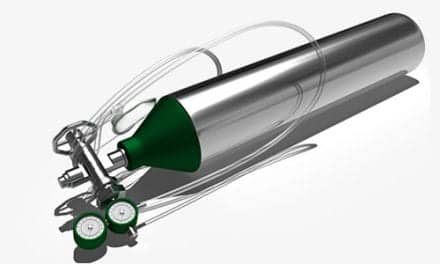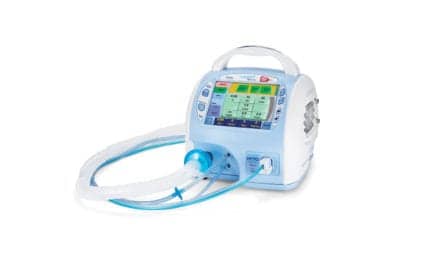For patients with cystic fibrosis, airway clearance physical therapy appointments have moved online and at-home lung function testing has become commonplace during the COVID-19 pandemic.
By Lisa Spear
We all produce mucus in our lungs, but in cystic fibrosis (CF) patients this mucus is thicker, heavier, and a breeding ground for harmful pathogens that can lead to life-threatening infection or even respiratory failure. Airway clearance, the act of pushing mucus out of the respiratory system, is a part of daily routine care for most CF patients. Manual physical therapy techniques and the use of specially designed vests that vibrate to jiggle the secretions free are some of the more popular ways to clear the airways.
Under normal circumstances, physical therapists meet with patients during in-person appointments to work on chest physical therapy (Chest PT), airway clearance techniques that help to drain the lungs. But as the novel coronavirus, SARS-CoV-2, spread in the United States in-person patient visits plummeted and people looked for new ways to communicate with their clinical team remotely.
“Patients were very anxious about their increased risk of coronavirus-related disease and were really anxious to come for cystic fibrosis visits of any kind,” said Robert J. Giusti, MD, the founder and director of the NYU Langone Pediatric Cystic Fibrosis Center in New York City.
In March, many airway clearance physical therapy appointments moved online. At the Hassenfeld Children’s Hospital at NYU Langone’s Pediatric Cystic Fibrosis Center, physical therapists have conducted weekly telemedicine visits with patients to monitor their airway clearance program adherence.
Home spirometers have become commonplace to help patients monitor their lung function. And previous restrictions on telehealth coverage and reimbursement were quickly relaxed as medical centers across the United States began to limit in-person clinical appointments, and the availability of telehealth increased rapidly.1
Digital cloud-based platforms and smartphone applications allowed clinicians and patients to cope. Some CF care centers encouraged patients to send mail-in respiratory sputum samples, so clinicians could to monitor for infection, while keeping a distance.
A pediatric pulmonologist, Carlos Milla, MD, who works with patients at Lucile Packard Children’s Hospital in Palo Alto, said he is relying on airway clearance vests that have built-in wireless Internet capabilities to monitor patient adherence while they use their devices at home.
Many newer airway clearance vests, Milla said, collect data that indicate how long a patient is using their device. The data is then stored on an easily accessible cloud-based platform.
One example is the high-frequency chest-wall oscillation Monarch system vest, designed by Hill-Rom, which incorporates wireless Internet to keep healthcare providers in the loop on their patient’s progress. The system comes with an online portal to facilitate communication between patients and providers. The portal also receives automatic updates from the patient’s respiratory care devices at home.
“During the pandemic, we have been looking at how to exploit all the different tools that are available right now to enhance adherence and motivation for keeping up with daily care,” said Milla, who works with Stanford Children’s Health.
He isn’t alone. The network of approximately 133 specialized CF care centers throughout the United States shifted to telemedicine since March, according to information from the Cystic Fibrosis Foundation, a non-profit organization dedicated to improving the lives of people with CF.
“There has been more than a five-fold increase in virtual visits compared to last year,” Michael Boyle, MD, president and CEO of the Cystic Fibrosis Foundation and founder of the Johns Hopkins Adult CF Care Center, wrote in a recent editorial. And while telehealth is by no means completely comprehensive, it does have many benefits, including decreased travel time. Providers report that patients are less likely to miss appointments and are checking in with clinicians more regularly.
Under normal circumstances, according to Boyle, 10% of people living with CF report skipping in-person care center visits due to the cost of transportation. Continued opportunity for virtual visits would enable preventive care for people with CF who may otherwise be unable to attend routine visits. In many instances, at-home monitoring and telemedicine solutions have provided more accessible care to patients who might not otherwise come to in-office visits as recommended.
“I think telemedicine is a very positive thing. Telemedicine gave us an opportunity to increase the availability of physical therapists working with the patients, even on a weekly basis initially,” said Giusti.”The physical therapists are able to advocate for them and review with them additional therapies.”
During virtual appointments, therapists are able to more thoroughly review chest PT techniques, in which the patient gets in different positions to use gravity to drain mucus from the five lobes of the lungs. The positions are designed so that a major part of the lung is facing downward. This method may be combined with percussion, when a caregiver can clap and or vibrate the patient’s chest to further move the mucus to the larger airways where it can be coughed up. Other techniques may include deep breathing, huffing or coughing.
Giusti’s patients are also monitoring their lung function at home using spirometers that were distributed by the CF Foundation.
In 2020, the CF Foundation supported care centers by delivering 10,000 home spirometers for remote monitoring, said Katie Haswell, communications manager of policy and advocacy at the CF Foundation. “The Foundation is working with care centers to integrate telehealth into the CF care model, in order to enrich it, but not replace in-person care all together after the pandemic,” said Haswell.
Another CF center in Dallas, Children’s Health at UT Southwestern Medical Center, also uses spirometers provided by the CF Foundation, the Zephryx home spirometer system.
Clinicians at the Dallas center have reported that the ability to monitor patients in real-time with the Zephryx system has proved beneficial. The system also includes a coaching feature that patients can use to stay motivated, according to information provided by the CF Foundation.
A Zephryx smartphone app that runs on both Apple and Android devices comes with visual aids to guide patients through lung function testing. The app includes coaching, games, and a digital “Breath Journal” to track daily performance.
Providers have access to a remote dashboard that charts the patient’s flow-volume loop that plots the inspiratory and expiratory flow using several lung function measurements. To name a few, the system tracks the forced vital capacity (FVC), the amount of air that can be exhaled from the lungs after taking a deep breath, as well as the forced expiratory volume, the amount of air that can be forced from the lungs in one second. “Cystic Fibrosis Foundation not only advocated for telemedicine, but also to have free home spirometers delivered to patients,” said Giusti.
While his patients benefit from the spirometer program, they opted out of the online provider dashboard, instead having their patients email them spirometer readings, a monitoring method that has worked well for them, Giusti reported.
Another CF center that pivoted to virtual care during the pandemic, the Virginia Commonwealth University’s Adult Cystic Fibrosis Center in Henrico, Virginia started organizing Zoom meetings with patients in early March. Respiratory therapists coordinate meetings with other clinical staff to juggle the specific needs of each patient.
A survey, published in the International Journal of General Medicine, demonstrated the success of the program with all surveyed patients reporting that they felt the addition of telehealth was a positive supplement to their care. The survey also showed that the majority of Virginia Commonwealth University’s Adult Cystic Fibrosis Center’s patients felt there would be improved access to care with telehealth: 90% reported that they felt telehealth would have either no effect or positive impact on their relationship with their CF care team, and 80% said that they support future telehealth initiatives at the center.2
Even before the pandemic, clinicians sought out innovative ways to keep patients on track with their airway clearance therapy. Researchers have observed that trying to make therapy fun by creating video games may help young CF patients stay motivated.3
Researchers at the University of Vermont in Burlington observed that many children with CF adhere poorly to airway clearance techniques and would prefer to play video games that challenge their dexterity and visual tracking skills. They went on to develop spirometer video games to elicit forced expiratory breath maneuvers, reporting their findings in the peer-reviewed journal Clinical Pediatrics.4
“It was concluded that an electronic breath game is safe and can improve breath awareness among children with CF. This technology could also contribute to awareness of respiratory symptoms and foster social ties among CF patients,” the authors wrote.
Online exercise programs are another way to keep this vulnerable population active even when gyms and schools are closed during periods of lockdown. During the summer months, the CF Foundation released free workout sessions online. “CF patients could log in to one of these exercise programs that were done remotely with other CF patients participating, so that was a very positive thing in terms of getting them into a exercise protocol,” said Giust.
Additionally, some of Milla’s patients have turned to smartphone app symptom trackers and organizers to monitor their progress. “We have spent a lot of time figuring out how to best keep in touch and how to best monitor their status at home,” said Milla.
Quality of care, he said, has not faltered. Even infection monitoring can be done remotely. His office now supplies patients with mailers to ship the sputum sample to the lab. “We are very aggressive about monitoring for respiratory infections and treating them early,” he said.
The pandemic has brought many unanticipated surprises, and one of them is that many CF patients have become healthier during the last year, less likely to visit the hospital, and in some cases, more likely to stay adherent to their airway clearance therapy.
A pediatric pulmonologist in Florida, Deanna Green, MD, MHS, said her patients have become more adherent to their airway clearance therapy during the pandemic. “What we are seeing from all of our patients is that they actually have been much more diligent with using their treatments,” said Green.
RT
Lisa Spear is associate editor of RT. For more information, contact [email protected].
References
- Fisk M, et al. Telehealth in the Context of COVID-19: Changing Perspectives in Australia, the United Kingdom, and the United States. J Med Internet Res. 2020 Jun 9; 22(6):e19264.
- Womack C. Emerging Alternatives to Conventional Clinic Visits in the Era of COVID-19: Adoption of Telehealth at VCU Adult Cystic Fibrosis Center. Int J Gen Med. 2020; 13: 1175–1186.
- Balli F. Developing Digital Games to Address Airway Clearance Therapy in Children With Cystic Fibrosis: Participatory Design Process. JMIR Serious Games. 2018 Oct-Dec; 6(4): e18.
- Bingham P, et al. A breath biofeedback computer game for children with cystic fibrosis. Clin Pediatr. 2010 Apr;49(4):337-42.










